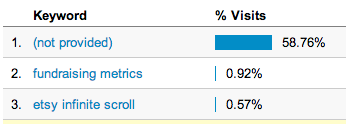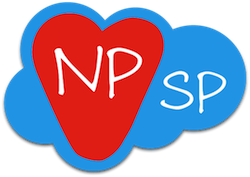|
For those watching this little blog, you've seen us up our game over the last couple of months to publish regular content on tech strategy and news you can use to supercharge your mission. 'Cause, in the spirit of the O'Jays classic, we're aiming to give the people what they want. Make sure you don't miss a beat and follow us on Twitter at @picnet for all the latest news.
Idealist Consulting has helped over 500 nonprofits and higher ed institutions deploy Salesforce, including organizations implementing Soapbox Engage for online donations, event management, serachable directories, and form submission that integrate with Salesforce. Not every organization looking to roll out a brand new web presence has the advantage Holy Trinity Church of Georgetown Pike (HTC) enjoyed: a volunteer leading the project who has been founder and CEO of several DC area technology startups. Phillip Merrick knew the possibilities of a robust and integrated online presence and its importance to a startup, whether that be a business or a church: "As a newly formed church preparing to launch our ministries and outreach, we needed more than just a website. We needed a platform to support a digital footprint spanning social media, web video and traditional email marketing, together with an integrated database on the back-end." We posted a great little tidbit the other day regarding the authorship service available to Google+ Profile owners and how it can help increase traffic to your site. By following Google's instructions for verifying authorship of content on a website, search results will display your Google+ Profile headshot and a link to other content you've written, increasing the likelihood that your link will get clicked: We followed the instructions provided by Google for our own blog and can report back the following: PICnet, Dupont Circle, Washington, DC Register today! Salesforce.com is predicted to become the leading constituent relationship management (CRM) application in the world in 2013. It is ranked as the most innovative company in the world by Forbes. That's ahead of Apple and Amazon and others. And it gives away its product away free of charge for up to 10 user licenses to nonprofits and higher education institutions - with deep discounts beyond those initial 10 licenses. More and more organizations are adopting Salesforce.com as their CRM of choice to supercharge social change. There are more than 16,000 that have done so already. How can your organization get the most out of Salesforce.com to transform its mission through a CRM that works as hard as you do? Nonprofits have several ways individuals can support their missions - through volunteering, attending an event, signing a petition, making a donation, becoming a member, and more. Nonprofits would love to have each individual support them in ALL of the ways they provide. Like any relationship, those steps of engagement with your organization happen incrementally over time. Just as one doesn't meet a promising someone at a bar and instantly get down on one knee to pop the question, organizations need to work a little romance over time to nurture and expand a relationship with each individual. That's called moving them up the engagement ladder in nonprofit-speak.
Each quarter, B Lab, the nonprofit organization that supports and fosters businesses to solve social and environmental problems, holds a State of the B Corp address where they update all the B Corps on what success they've had in the last quarter. And from last week's call, I can tell you that B Corps had a banner 2012! Here are some highlights:
Unlike the longer video clips that you're probably producing and then distributing via other channels such as YouTube or Vimeo, Twitter purposefully intends to make you focus on getting to the point very, very fast. Your video displays directly within your Tweet, and directly within your Twitter stream. The videos you produce on Vine loop, and for those that remember the good old days of Web 1.0, definitely have a feeling of the animated GIF returning to popular culture. Twitter describes Vine like this: Posts on Vine are about abbreviation — the shortened form of something larger. They're little windows into the people, settings, ideas and objects that make up your life. They're quirky, and we think that's part of what makes them so special. As communication professionals trying to move supporters and donors up the ladder of engagement, how might Vine be useful for your online communication strategies? Here's a few ideas that could be useful for organizations starting to explore the benefits of these short video clips.
Pretty lofty stuff, right? What I think is most interesting, however, is that we were talking about increasing operational efficiency for organizations as a tech startup growing at the height of the dot-com boom. That was quite different from what other Web development firms were doing back then, most of which was pitching hip things you can do with a Flash-based website, imploring the need to invest deep 5-digit budgets into shiny bells and whistles for websites, and encouraging the building of custom or proprietary software. So when Nancy Schwartz, publisher of the Getting Attention blog, shared her request for feedback on this year's Nonprofit Blog Carnival, I thought it would be good for us at PICnet to share one of our dreams for the social sector in 2013.
I've experienced it all in growing a small business, as most boot-strappers have before me. From the soaring to the highest of highs, to the falling to the lowest of lows. Through the process, I've learned more than I ever could have imagined about business, but more importantly, about the relationships you build with others that keep you moving forward. I'm so incredibly thankful to have been blessed with such a great support network of people that truly care about me. As I say quite often, the relationships we build are more important than the tools we build. But even with friends, family, and loved ones there to support you, few, if any, really understand what is running through that entrepreneurial head of yours. No matter how fantastic your business is doing, as an entrepreneur, you're always working harder than you were the day before. Running through our minds is often the quote from Andy Grove: "only the paranoid survive." If you're a fellow entrepreneur, or you're getting ready to venture off into the startup of your own business, I have one small bit of advice for you. Don't go it alone. Now, don't get me wrong, I'm not speaking about your business partner decision. I'm talking about starting right now, today, your very own entrepreneurial social safety net. This is the first of an occasional PICnet blog series: Project Management Quick Tip. These quick tips are lessons that we Project Managers have learned in our work to keep things on time, on budget, and most importantly, to make sure that we have happy clients. We, the PICnet Project Management team, may not be perfect but we are constantly pursuing greatness - yes, greatness! We offer these tips from lessons learned in that pursuit. Here's our first quick tip that will hopefully help you in your own project management work: Develop a start and end of the week (and day) routineIn the past few months at PICnet, we've been focusing heavily on increasing our marketing efforts, particularly through our blog. Just as we do for most top-level programs, we've set goals, take regular measurements, analyze the results in detail, the rinse and repeat. Our tool of trade for building our metrics for success is Google Analytics, and it's been serving us amazingly well. As we're seeing further increases in traffic, we're interested in knowing what people were searching when they found our site. Knowing that information allows us to better define our content strategies for the future, and give us a sense of what content is most interesting to those searching for answers online. It seems, however, that the most popular search keyword, by huge margins, is "(not provided)". And when I say huge margins, I mean it's 58x more popular a keyword than number two. What is this "(not provided)" keyword in Google , and why are we getting so much traffic from it?
Earlier today, we covered how the Obama campaign successfully utilized it's strong database tools to run important A/B communication testing to determine message effectiveness. While it's going to be rare for an advocacy group to have the war chest of funds that the presidential campaigns had this year, there's a powerful database tool that we believe is about to see a significant uptick in the advocacy world in 2013: Salesforce.com. The question: how can your advocacy group get started using Salesforce, and even the open source Nonprofit Starter Pack (NPSP), to build a successful campaign database and platform? Here's three ideas you can implement right away to start using Salesforce for your advocacy work. As the nation's capital cleans up from the weekend's Inaugural festivities, it's worth asking how we got here: How was it that President Obama came to be standing on the steps of the Capitol being sworn for a second term rather than his rival, Governor Mitt Romney, being sworn in for his first? One undeniable factor was that Obama's Digital Team ran one of the most successful online campaigns ever. Curious about how?
For some of you, open source software might be a new and somewhat mysterious concept. Luckily, there's a not-so-well-kept secret to but the immense power of it is what enables so many fabulous organizations to use the Nonprofit Starter Pack (NPSP): you have the power to contribute to it and make it better. The question is, how? If you're a member organization looking to offer tasty content for a members-only area, we offered a tantalizing idea on Friday for providing logged in users access to private contact information of other members in Salesforce. A valuable service to your members with no additional website management for you. Today is the same song different verse, this one to the tune of the cash register. If you collect dues and track them in Salesforce, you've got a pile of valuable data about the times your members have rung the cash register. Add value to your members-only area by providing logged in users a list of their past payments. Include amounts and dates. Let them know when their membership expires. All through integrating your website with your Salesforce instance. Tell us if this sounds familiar: you're a membership organization that wants to have a members-only section - but you have no idea what to put in your members-only section that will encourage members to login and login often? You're not alone. It's a common dilemma member organizations face. Since content is king on the interwebs, you don't want to unnecessarily restrict great content to only logged in members when if really should be public. You also likely don't have time to create regular and robust content exclusively for a members-only section. So, how do you share enticing, mouth-watering members-only content they'll want to login to dig into without doubling your web management task? For websites integrating with Salesforce, there will be a few great ideas to consider. None will require additional staff time to manage content beyond what you already do. Each will encourage folks to login.
But what if a simple technology switch could more effectively highlight your organization's website content in search engine results, and thereby make it more likely that visitors would click on your links rather than others? And what if the solution was easy and affordable? I figure you'd probably try it. So, what's this differentiator you can implement immediately for your website? It's called Rich Snippets. I recently logged into my account with a major financial services company for the first time in awhile. The next day, I received an email from the company saying “Hey! Thanks for stopping by our site yesterday! S'up?” That wasn’t verbatim, mind you. But it was close. And it prompts the first in our blog series of simple ideas for successful online nonprofit membership management using Salesforce. Are you rolling out the online welcome mat for your members? How can you tell and how can you improve so that welcome mat is more welcoming? |




 As a
As a  On Thursday last week,
On Thursday last week,  When we started
When we started  Incredibly enough, in a few weeks, our company
Incredibly enough, in a few weeks, our company 


 With this week's second inauguration of President Obama, and the announcement of the new
With this week's second inauguration of President Obama, and the announcement of the new ![Presidential Inaugural Parade [Image 11 of 11]](“https://farm9.staticflickr.com/8192/8408206403_480473c8aa.jpg”)
 If you're one of the thousands of organizations using the
If you're one of the thousands of organizations using the  I've often found my self saying the words, "technology is not a panacea", whenever I hear organizations looking to focus what I think are excessive energy on search engine optimization. My thoughts have been that spending that time and money on writing great content, rather than trying to manipulate search engine rankings.
I've often found my self saying the words, "technology is not a panacea", whenever I hear organizations looking to focus what I think are excessive energy on search engine optimization. My thoughts have been that spending that time and money on writing great content, rather than trying to manipulate search engine rankings.